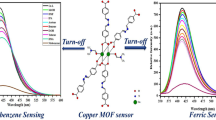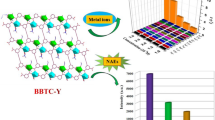Abstract
A two-dimensional threefold interpenetrated uranium-organic framework (UOF) has been synthesized by the solvothermal method with a highly luminescent response of various molecules. The structure of the compound is characterized by the single-crystal X-ray diffraction, [C27H17O11U] [C2H6N]·DMF·2H2O·(UTCPB), with a six-coordinated uranyl cation, further proved by the IR, TG and others tests. To explore the functional properties, photoluminescent, dye adsorption, and metal detecting properties have been also studied and discussed initially. The results showed that the compound exhibited some features in dye adsorption (RhB) and Ru3+ detection.









Similar content being viewed by others
Data availability
The datasets generated during and analyzed during the current study are available from the corresponding author on reasonable request.
References
Bai Y, Zhang S, Feng S, Zhu M, Ma S (2020) The first ternary Nd-MOF/GO/Fe3O4 nanocomposite exhibiting an excellent photocatalytic performance for dye degradation. Dalton Trans 49:10745–10754
Barthel S, Alexandrov EV, Proserpio DM, Proserpio BS (2018) Distinguishing metal-organic frameworks. Cryst Growth Des 18:1738–1747
Chen HY, Wang FF, Fan HZ, Hong RY, Li WH (2021a) Construction of MOF-based superhydrophobic composite coating with excellent abrasion resistance and durability for self-cleaning, corrosion resistance, anti-icing, and loading-increasing research. Chem Eng J 408:127343
Chen LT, Tian HH, Hu GF, Zhao JS, Liu CY, Weng NS (2021b) Uranium MOF derivative based on 2, 2′, 2″-[1 4, 6-triyltris (thio)] trisacetic acid as sensor for ruthenium (III) and biomolecules. J Solid State Chem 300:122217
Dai Y, Chai HM, Zhang RX, Min JA, Wang Z, Zhang M, Zhang Y, Feng J, Zhang C, Wang J (2020) A series of uranium-organic frameworks: crucial role of the protonation ability of auxiliary ligands. Inorg Chem Commun 111:107628
Du Y, Liu H (2020) Cage-like silsesquioxanes-based hybrid materials[J]. Dalton Trans 49(17):5396–5405
Gu D, Yang W, Chen H, Yang Y, Qin X, Chen L, Wang S, Pan Q (2021) A stable mixed-valent uranium(v, vi) organic framework as a fluorescence thermometer. Inorg Chem Front 8:3514–3521
Gulbalkan HC, Haslak ZP, Altintas C, Uzun A, Keskin S (2022) Assessing CH4/N2 separation potential of MOFs, COFs, IL/MOF, MOF/polymer, and COF/polymer composites. Chem Eng J 428:131239
Hanikel N, Prevot MS, Yaghi OM (2020) MOF water harvesters. Nat Nanotechnol 15:348–355
Li L, Chen Q, Niu Z, Zhou X, Yang T, Huang W (2016) Lanthanide metal-organic frameworks assembled from a fluorene-based ligand: selective sensing of Pb2+ and Fe3+ ions. J Mater Chem C 4:1900–1905
Li X, Huang L, Kochubei A, Huang J, Shen W, Xu H, Li Q (2020) Evolution of a metal-organic framework into a bronsted acid catalyst for glycerol dehydration to acrolein. Chemsuschem 13:5073–5079
Liao ZL, Li GD, Wei X, Yu Y, Chen JS (2010) Construction of three-dimensional uranyl-organic frameworks with benzenetricarboxylate ligands. Eur J Inorg Chem 2010:3780–3788
Lin XM, Niu JL, Chen DN, Lu YN, Zhang G, Cai YP (2016) Four metal-organic frameworks based on a semirigid tripodal ligand and different secondary building units: structures and electrochemical performance. CrystEngComm 18:6841–6848
Martinez-Ahumada E, Diaz-Ramirez ML, Velasquez-Hernandez MJ, Jancik V, Ibarra IA (2021) Capture of toxic gases in MOFs: SO2, H2S, NH3 and NOx. Chem Sci 12:6772–6799
Mei L, Wang CZ, Zhu LZ, Gao ZQ, Chai ZF, Gibson JK, Shi WQ (2017) Exploring new assembly modes of uranyl terephthalate: templated syntheses and structural regulation of a series of rare 2d → 3d polycatenated frameworks. Inorg Chem 56:7694–7706
Meng WJ, Hao JY, Tong ZS, Liu H, Li Y, Zhang XX (2021) Cu(II) and Co(II) coordination polymers: magnetic properties, regulating the YAP signaling pathway activation and exerting anticancer activity against breast cancer combined with Sevoflurane. Inorg Chim Acta 516:120108
Newar R, Akhtar N, Antil N, Kumar A, Shukla S, Begum W, Manna K (2021) Amino acid-functionalized metal-organic frameworks for asymmetric base-metal catalysis. Angew Chem Int Ed 60:10964–10970
Ngue CM, Leung MK, Lu KL (2020) An Electroactive zinc-based metal-organic framework: bifunctional fluorescent quenching behavior and direct observation of nitrobenzene. Inorg Chem 59:2997–3003
Pang ZH, Luo F (2020) A highly rare 3D U-Cu metal-organic framework showing three-connected srs topology and nine-fold interpenetration. Inorg Chem Commun 119:108041
Park HJ, Oh J, Jiwon K, Jaheon K (2020) Two-step gas adsorption induced by the transmetallation in a two-dimensional metal-organic framework. Chem Commun (camb) 56:9727–9730
Snider JL, Su J, Verma P, Gabaly FE, Sugar JD, Chen L, Chames JM, Talin AA, Dun C, Urban JJ (2021) Stabilized open metal sites in bimetallic metal-organic framework catalysts for hydrogen production from alcohols. J Mater Chem A 9:10869–10881
Soldatov M, Liu H (2021) Hybrid porous polymers based on cage-like organosiloxanes: synthesis, properties and applications. Prog Polym Sci 119:101419
Tang SF, Hou X (2019) Structural tuning and sensitization of uranyl phosphonates by incorporation of countercations into the framework. Inorg Chem 58:1382–1390
Wang S, Bai J, Xing H, Li Y, Song Y, Pan Y, Scheer M, You X (2007) Novel alternating ferro-ferromagnetic two-dimensional (4,4) and photoluminescent three-dimensional interpenetrating pts-type coordination networks constructed from a new flexible tripodal ligand as a four-connected node. Cryst Growth Des 7:747–754
Wang J, Zhang Y, Zhang P, Hu J, Lin RB, Deng Q, Zeng Z, Xing H, Deng S, Chen B (2020) Optimizing pore space for flexible-robust metal-organic framework to boost trace acetylene removal. J Am Chem Soc 142:9744–9751
Won S, Jeong S, Kim D, Seong J, Lim J, Moon D, Baek SB, Lah MS (2021) Transformation of a cluster-based metal-organic framework to a rod meta-organic framework. Chem Mater 34:273–278
Wu HY, Wang RX, Yang W, Chen J, Sun ZM, Li J, Zhang H (2012) 3-Fold-interpenetrated uranium-organic frameworks: new strategy for rationally constructing three-dimensional uranyl organic materials. Inorg Chem 51:3103–3107
Yang Y, Ok YS, Kim KH, Kwon EE, Tsang YF (2017) Occurrences and removal of pharmaceuticals and personal care products (PPCPs) in drinking water and water/sewage treatment plants: a review. Sci Total Environ 596:303–320
Yuan N, Gong X, Sun W, Yu C (2021) Advanced applications of Zr-based MOFs in the removal of water pollutants. Chemosphere 267:128863
Zhang J, Huo LQ, Wang XQ, Fang KG, Fan LM, Hu TP (2017) Structural diversity, magnetic properties, and luminescent sensing of the flexible tripodal ligand of 1,3,5-tris(4-carbonylphenyloxy)benzene based Mn(ii)/Cd(ii) coordination polymers. Cryst Growth Des 17:5887–5897
Zhang J, Liang J, Wang Y, Zhai L, Niu X, Hu T (2019a) Synthesis and electrochemical properties of temperature-induced two metal-organic frameworks-based electrodes for supercapacitor. Cryst Growth Des 20:460–467
Zhang N, Xing YH, Bai FY (2019b) A uranyl-organic framework featuring two-dimensional graphene-like layered topology for efficient iodine and dyes capture. Inorg Chem 58:6866–6876
Zhang YG, Chen LH, Guan JW, Wang X, Wang SA, Di WJ (2020) A unique uranyl framework containing uranyl pentamers as secondary building units: synthesis, structure, and spectroscopic properties. Dalton Trans 49(12):3676–3679
Zhao YN, Zhang SR, Wang W, Xu YH, Che GB (2018) A 3D metal-organic framework with dual-aerial-octahedral trinucleate building units: synthesis, structure and fluorescence sensing properties. New J Chem 42:14648–14654
Funding
This work was supported by the National Natural Science Foundation of China (No.21671156).
Author information
Authors and Affiliations
Contributions
LTC, Draft writing and the synthesis of the material; XLZ, Basic characteristic of the material; GFH, Data analysis; NSW, Crystal structure refinement; JSZ, Finical supporting and supervisor; CYL, Supervisor.
Corresponding authors
Ethics declarations
Conflict of interest
The authors have no relevant financial or non-financial interests to disclose.
Additional information
Publisher's Note
Springer Nature remains neutral with regard to jurisdictional claims in published maps and institutional affiliations.
Supplementary Information
Below is the link to the electronic supplementary material.
Rights and permissions
Springer Nature or its licensor (e.g. a society or other partner) holds exclusive rights to this article under a publishing agreement with the author(s) or other rightsholder(s); author self-archiving of the accepted manuscript version of this article is solely governed by the terms of such publishing agreement and applicable law.
About this article
Cite this article
Chen, LT., Zhang, XL., Hu, GF. et al. The construct of a novel threefold interpenetrating uranium-organic framework as a sensor for detecting Ru3+. Chem. Pap. 77, 1721–1727 (2023). https://doi.org/10.1007/s11696-022-02587-1
Received:
Accepted:
Published:
Issue Date:
DOI: https://doi.org/10.1007/s11696-022-02587-1




